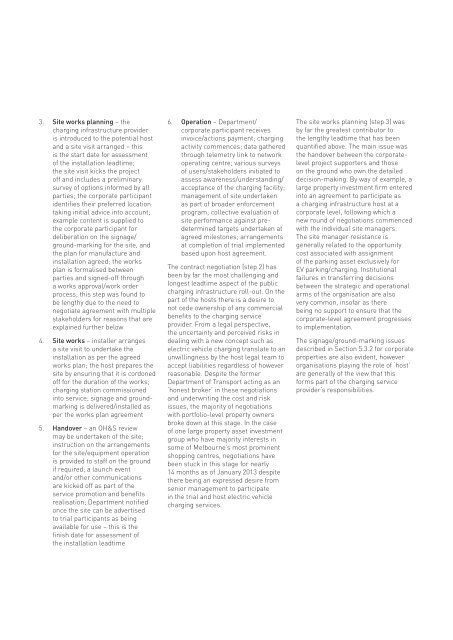victorian electric vehicle trial mid-term report - Department of Transport
victorian electric vehicle trial mid-term report - Department of Transport
victorian electric vehicle trial mid-term report - Department of Transport
- No tags were found...
Create successful ePaper yourself
Turn your PDF publications into a flip-book with our unique Google optimized e-Paper software.
3. Site works planning – thecharging infrastructure provideris introduced to the potential hostand a site visit arranged – thisis the start date for assessment<strong>of</strong> the installation leadtime;the site visit kicks the project<strong>of</strong>f and includes a preliminarysurvey <strong>of</strong> options informed by allparties; the corporate participantidentifies their preferred locationtaking initial advice into account;example content is supplied tothe corporate participant fordeliberation on the signage/ground-marking for the site, andthe plan for manufacture andinstallation agreed; the worksplan is formalised betweenparties and signed-<strong>of</strong>f througha works approval/work orderprocess; this step was found tobe lengthy due to the need tonegotiate agreement with multiplestakeholders for reasons that areexplained further below4. Site works – installer arrangesa site visit to undertake theinstallation as per the agreedworks plan; the host prepares thesite by ensuring that it is cordoned<strong>of</strong>f for the duration <strong>of</strong> the works;charging station commissionedinto service; signage and groundmarkingis delivered/installed asper the works plan agreement5. Handover – an OH&S reviewmay be undertaken <strong>of</strong> the site;instruction on the arrangementsfor the site/equipment operationis provided to staff on the groundif required; a launch eventand/or other communicationsare kicked <strong>of</strong>f as part <strong>of</strong> theservice promotion and benefitsrealisation; <strong>Department</strong> notifiedonce the site can be advertisedto <strong>trial</strong> participants as beingavailable for use – this is thefinish date for assessment <strong>of</strong>the installation leadtime6. Operation – <strong>Department</strong>/corporate participant receivesinvoice/actions payment; chargingactivity commences; data gatheredthrough telemetry link to networkoperating centre; various surveys<strong>of</strong> users/stakeholders initiated toassess awareness/understanding/acceptance <strong>of</strong> the charging facility;management <strong>of</strong> site undertakenas part <strong>of</strong> broader enforcementprogram; collective evaluation <strong>of</strong>site performance against prede<strong>term</strong>inedtargets undertaken atagreed milestones; arrangementsat completion <strong>of</strong> <strong>trial</strong> implementedbased upon host agreement.The contract negotiation (step 2) hasbeen by far the most challenging andlongest leadtime aspect <strong>of</strong> the publiccharging infrastructure roll-out. On thepart <strong>of</strong> the hosts there is a desire tonot cede ownership <strong>of</strong> any commercialbenefits to the charging serviceprovider. From a legal perspective,the uncertainty and perceived risks indealing with a new concept such as<strong>electric</strong> <strong>vehicle</strong> charging translate to anunwillingness by the host legal team toaccept liabilities regardless <strong>of</strong> howeverreasonable. Despite the former<strong>Department</strong> <strong>of</strong> <strong>Transport</strong> acting as an‘honest broker’ in these negotiationsand underwriting the cost and riskissues, the majority <strong>of</strong> negotiationswith portfolio-level property ownersbroke down at this stage. In the case<strong>of</strong> one large property asset investmentgroup who have majority interests insome <strong>of</strong> Melbourne’s most prominentshopping centres, negotiations havebeen stuck in this stage for nearly14 months as <strong>of</strong> January 2013 despitethere being an expressed desire fromsenior management to participatein the <strong>trial</strong> and host <strong>electric</strong> <strong>vehicle</strong>charging services.The site works planning (step 3) wasby far the greatest contributor tothe lengthy leadtime that has beenquantified above. The main issue wasthe handover between the corporatelevelproject supporters and thoseon the ground who own the detaileddecision-making. By way <strong>of</strong> example, alarge property investment firm enteredinto an agreement to participate asa charging infrastructure host at acorporate level, following which anew round <strong>of</strong> negotiations commencedwith the individual site managers.The site manager resistance isgenerally related to the opportunitycost associated with assignment<strong>of</strong> the parking asset exclusively forEV parking/charging. Institutionalfailures in transferring decisionsbetween the strategic and operationalarms <strong>of</strong> the organisation are alsovery common, ins<strong>of</strong>ar as therebeing no support to ensure that thecorporate-level agreement progressesto implementation.The signage/ground-marking issuesdescribed in Section 5.3.2 for corporateproperties are also evident, howeverorganisations playing the role <strong>of</strong> ‘host’are generally <strong>of</strong> the view that thisforms part <strong>of</strong> the charging serviceprovider’s responsibilities.
















